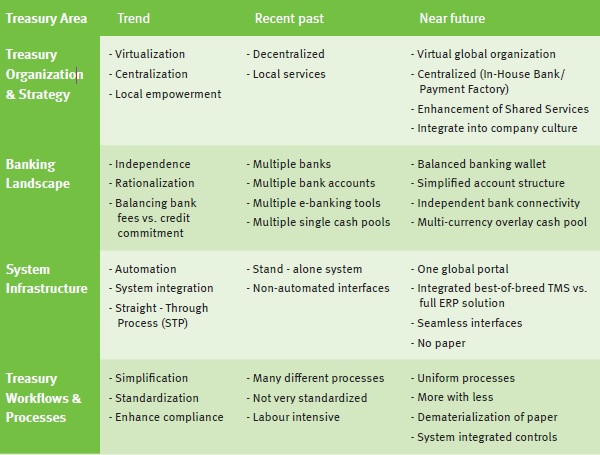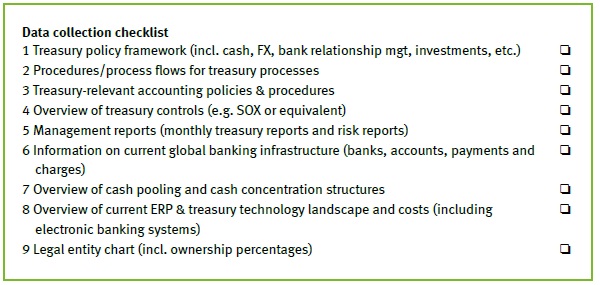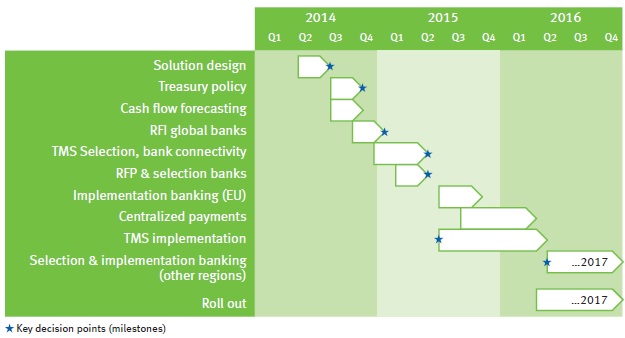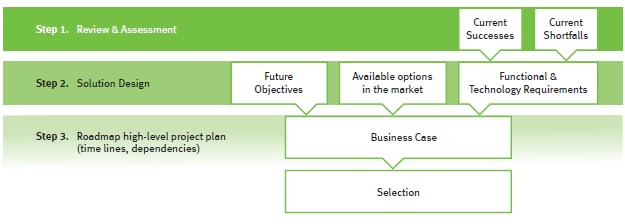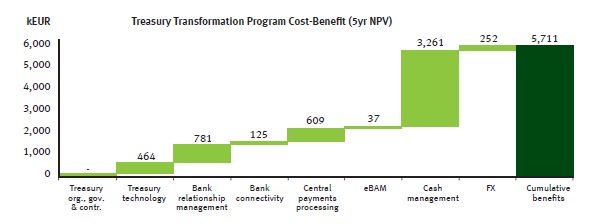Figure 5: Sample treasury roadmap
Step 4: Business Case
The next step in the treasury transformation program is to establish a business case.
Depending on the individual organization, some transformation programs will require only a very high-level business case, while others require multiple business cases; a high level business case for the entire program and subsequent more detailed business cases for each of the sub-projects.
Figure 6: Building a business case
The business case for a treasury transformation program will include the following three parts:
- The strategic context identifies the business needs, scope and desired outcomes, resulting from the previous steps
- The analysis and recommendation section forms the significant part of the business case and concerns itself with understanding all of the options available, aligning them with the business requirements, weighing the costs against the benefits and providing a complete risk assessment of the project
- The management and controlling section includes the planning and project governance, interdependencies and overall project management elements
Notwithstanding the financial benefits, there are many common qualitative benefits in transforming the treasury. These intangibles are often more important to the CFO and group treasurer than the financial benefits. Tight control and full compliance are significant features of world-class treasuries and, to this end, they are typically top of the list of reasons for embarking on a treasury transformation program. As companies grow in size and complexity, efficiency is difficult to maintain. After a period of time there may need to be a total overhaul to streamline processes and decrease the level of manual effort throughout the treasury organization. One of the main costs in such multi-year, multi-discipline transformation programs is the change management required over extended periods.
Figure 7: Sample cost-benefit
Figure 7 shows an example of how several sub-projects might contribute to the overall net present value of a treasury transformation program, providing senior management with a tool to assess the priority and resource allocation requirements of each sub-project.
Step 5: Selection(s)
Based on Zanders’ experience gained during previous treasury transformation programs, key evaluation & selection decisions are commonly required for choosing:
- bank partners
- bank connectivity channels
- treasury systems
- organizational structure
Zanders has assisted treasury departments with selection processes for all these components and has developed standardized selection processes and tools.
Selection process for bank partners
Common objectives for including the selection of banking partners in a treasury transformation program include the following:
- to align banks that provide cash and risk management solutions with credit providing banks
- to reduce the number of banks and bank accounts
- to create new banking architecture and cash pooling structures
- to reduce direct and indirect bank charges
- to streamline cash management systems and connectivity
- to meet the service requirements of the business; and
- to provide a robust, scalable electronic platform for future growth/expansion.
Zanders’ approach to bank partner selection is shown in Figure 8 below.
Figure 8: Bank partner selection process
Selection process for bank connectivity providers or treasury systems (treasury management systems, in-house banks, payment factories)
The selection of new treasury technology or a bank connectivity provider will follow the selection process depicted in Figure 9.
Figure 9: Treasury technology selection process
Organizational structure
If change in the organizational structure is part of the solution design, the need for an evaluation and selection of the optimal organizational structure becomes relevant. An example of this would be selecting a location for a FSSC or selecting an outsourcing partner. Based on the high-level direction defined in the solution design and based on Zanders’ extensive experience, we can advise on the best organization structure to be selected, on a functional, strategic and geographical level.
Step 6: Execution
The sixth step of treasury transformation is execution. In this step, the future-state treasury design will be realized. The execution typically consists of various sub-projects either being run in parallel or sequentially.
Zanders’ implementation approach follows the following steps during execution of the various treasury transformation sub-projects. Since treasury transformation entails various types of projects, in the areas of treasury organization, system infrastructure, treasury processes and banking landscape, not all of these steps apply to all projects to the same extent.
For several aspects of a treasury transformation program, such as the implementation of a payment factory, a common and tested approach is to go live with a number of pilot countries or companies first before rolling out the solution across the globe.
Figure 10: Zanders’ execution approach
Step 7: Post-Execution
The post-execution step of a treasury transformation is an important part of the program and includes the following activities:
6-12 months after the execution step:
– project review and lessons learned
– post implementation review focussing on actual benefits realized compared to the initial business case
On an ongoing basis:
– periodic benchmark and continuous improvement review
– ongoing systems maintenance and support
– periodic upgrade of systems
– periodic training of treasury resources
– periodic bank relationship reviews
Zanders offers a wide range of services covering the post-execution step.
Importance of a structured approach
There are many internal and external factors that require treasury organizations to increase efficiency, effectiveness and control. In order to achieve these goals for each of the treasury activities of treasury management, risk management and corporate finance, it is important to take a holistic approach, covering the organizational structure and strategy, the banking landscape, the systems infrastructure and the treasury workflows and processes. Zanders’ seven steps to treasury transformation provides such an approach, by working from a detailed as-is analysis to the implementation of the new treasury organization.
Why Zanders?
Zanders is a completely independent treasury consultancy f rm founded in 1994 by Mr. Chris J. Zanders. Our objective is to create added value for our clients by using our expertise in the areas of treasury management, risk management and corporate finance. Zanders employs over 130 specialist treasury consultants who are the key drivers of our success. At Zanders, our advisory team consists of professionals with different areas of expertise and professional experience in various treasury and finance roles.
Due to our successful growth, Zanders is a leading consulting firm and market leader in independent consulting services in the area of treasury and risk management. Our clients are multinationals, financial institutions and international organizations, all with a global footprint.
Independent advice
Zanders is an independent firm and has no shareholder or ownership relationships with any third party, for example banks, accountancy firms or system vendors. However, we do have good working relationships with the major treasury and risk management system vendors. Due to our strong knowledge of the treasury workstations we have been awarded implementation partnerships by several treasury management system vendors. Next to these partnerships, Zanders is very proud to have been the first consultancy firm to be a certified SWIFTNet management consultant globally.
Thought leader in treasury and finance
Tomorrow’s developments in the areas of treasury and risk management should also have attention focused on them today. Therefore Zanders aims to remain a leading consultant and market leader in this field. We continuously publish articles on topics related to development in treasury strategy and organization, treasury systems and processes, risk management and corporate finance. Furthermore, we organize workshops and seminars for our clients and our consultants speak regularly at treasury conferences organized by the Association of Financial Professionals (AFP), EuroFinance Conferences, International Payments Summit, Economist Intelligence Unit, Association of Corporate Treasurers (UK) and other national treasury associations.
From ideas to implementation
Zanders is supporting its clients in developing ‘best in class’ ideas and solutions on treasury and risk management, but is also committed to implement these solutions. Zanders always strives to deliver, within budget and on time. Our reputation is based on our commitment to the quality of work and client satisfaction. Our goal is to ensure that clients get the optimum benefit of our collective experience.
PDF Zanders Green Paper; 7 Steps to Treasury Transformation

